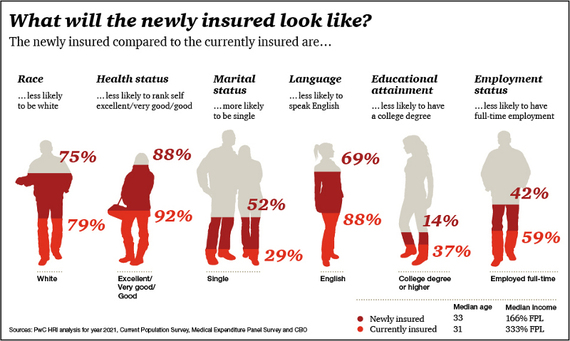
Everyone from U.S. Senators to major media outlets (USA Today, the New York Times, the Wall Street Journal) and advocacy outlets is talking about the primary care physician shortage. This shortage could grow as the number of insured Americans increases thanks to the Affordable Care Act (ACA). Estimates of how many physicians would fill the gap range from just over 20,000, according to HRSA, to 45,000, according to the AAMC. Half a century ago, 50 percent of our nation's physicians practiced primary care. How did we end up here?
First, medical students are taking a long, hard look at the job and deciding that the costs outweigh the benefits. Those who do pursue careers in primary care have some of the lowest salaries in the profession and face the greatest risk of burnout. In 2013, three of the five lowest paid physician groups were primary care physicians (Internal Medicine, $178,000; Family Medicine, $175,000; and Pediatrics, $173,000). Compare that to Orthopedics, $405,000, and Cardiology: $357,000. The median debt for medical graduates in 2014 was $180,000.
Even more worrying, nearly a third of primary care physicians age 35 to 49 -- doctors in the prime of their career, able to bring expertise and experience to their patients and to the workforce - plan to discontinue their practice within the next five years. That rate climbs to 50 percent for primary care physicians who are 50 and older.
Before the ACA, 60 million Americans lacked access to primary care. In 2014, more than 30 million newly insured Americans entered the health care system. Expanding the role of physician assistants and nurse practitioners and utilizing a non-clinical health care team of specialists like social workers, pharmacists, and health coaches can alleviate some of the pressure on primary care physicians. Health care IT and electronic health records also hold promise for making clinical work more efficient. But we need payment and training reform to reduce the salary disparity and train more primary care physicians. If we don't fix this problem, it will mean longer lines and greater delays in care for all of us.
Improving Supply Alone is Not Enough
In this problem of supply and demand, the search for solutions is unbalanced. The conversation has overwhelmingly focused on ways to increase the supply of physicians with little attention given to strategies to reduce the growing demand. The population is getting bigger, older, and sicker with increasingly costly and complicated chronic diseases. Heart conditions, injuries, asthma, diabetes, and hypertension alone account for nearly $300B in medical expenses annually, a figure that does not take into account lost productivity, increased insurance premiums, and other associated social costs. If demand continues to swell, the physician shortage will continue regardless of how many more primary care physicians enter the field.
While the U.S. is experiencing some of the lowest rates of uninsured since the late 1990s, the newly insured may come with additional untreated chronic diseases. The newly insured are less likely to rate their health as excellent, very good, or good, and they share other characteristics typically associated with poor health (e.g., less education, increased unemployment).

Infographic via Practice Consultants
Diseases that drive demand, like diabetes, hypertension, and heart disease, cannot be addressed solely through a visit to the doctor. Lifestyle choices, work and home environments, and other factors such as education, poverty, and community safety often undermine standard treatments such as surgery or medication.
Primary care physicians, no matter how many we have, can invest hours treating, medicating, and counseling patients with little or no impact on chronic disease prevalence. PCPs are asked to solve problems that are out of their control. They unfairly share blame when traditional clinical measures fail to yield the desired outcomes. There is, however, a partner ready to lighten the load on primary care with its practical know-how to improve population health.
A Public Health Partner to Solve the Primary Care Crisis
Public health leaders recognize that health is indelibly tied to where you live and work. By addressing community-level drivers of health, the public health system can help address the demand side of the primary care crisis by preventing disease before it occurs and creating a healthy, supportive environment for those who are already sick. Public health departments can partner with primary care providers in a community to set up flu vaccination clinics, help identify community or environmental causes of disease, and aggregate information across practices.
Primary care physicians are a trusted source of health information. However, patients see their health care providers only a few times each year for a limited amount of time. Public health delivers health promotion messages to the community as a whole. These messages may be more general, but they are also repetitive. Examples include partnering with barbers to talk to people about colon cancer, placing ads in movie theaters, and producing public service announcements through print and visual media. Working together, primary care and public health can deliver a formidable one-two punch so people hear the same information in the clinic and the community.
Furthermore, local health departments can amplify the work that primary care does on an individual level by bringing it to the community through regulatory and legislative solutions that can directly impact the health of the population. Child booster seat laws, clean indoor air ordinances, and zoning restrictions on bars and alcohol outlets are all examples of regulatory and legislative actions that seek to make the healthy choice the default choice. These community-level policies can improve community health and reduce the demand for primary care services. Physicians and other health care providers can provide input to shape these policies, and primary care's outspoken advocacy can be essential to a law's success.
Waiting for the Change?
We cannot afford to perpetuate a system that pressures clinicians to chase outcomes for problems that originate far beyond their reach. We must pursue transformation that aligns public health and primary care.
One way to start this transformation is by learning from those who have already blazed the trail. The online tool, the Practical Playbook: Public Health & Primary Care Together, has catalogued success stories from across the country documenting exactly how projects to improve population health were executed through primary care and public health partnerships. The Practical Playbook also provides guidance on developing, leading, and evaluating an integrated project.
Lloyd Michener, M.D., Chair of Duke University's Department of Community and Family Medicine and co-developer of the Practical Playbook said, "Partnerships between primary care and public health can amplify our efforts and reduce the number of people with chronic disease that need so much of our time. We need each other and our communities need us both -- together."
Changes in physician supply are needed but will take time. These efforts, however, will be for naught, if demand continues to grow. Increased collaboration between primary care and public health can start immediately, and it needs to if we are going to have any chance to reduce costs and improve both individual and population health.
Follow Brian C. Castrucci on Twitter at @brianccastrucci. The opinions expressed are not necessarily those of the de Beaumont Foundation.